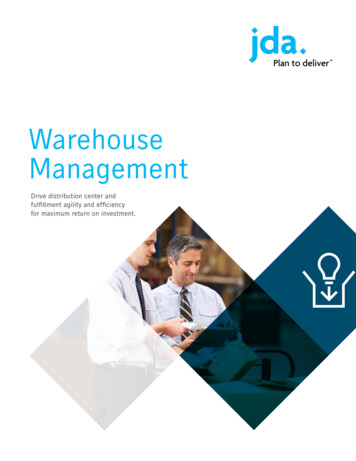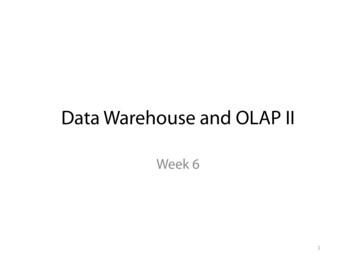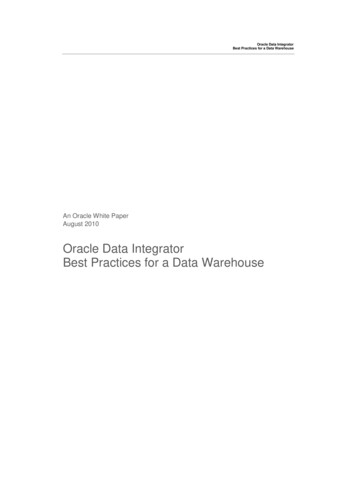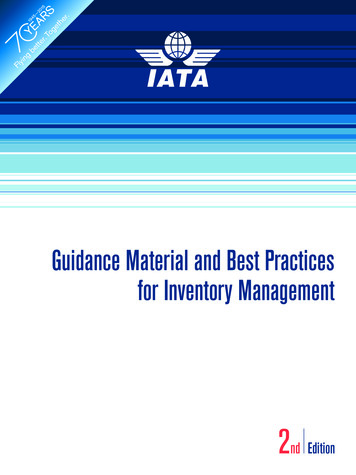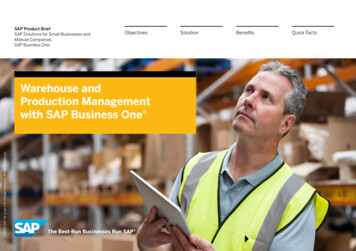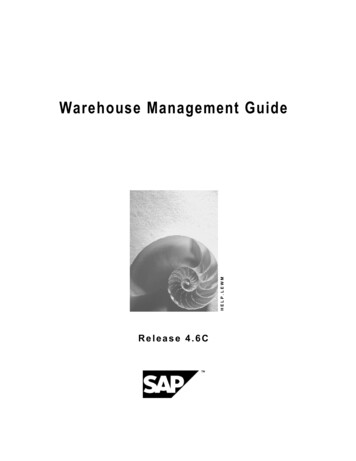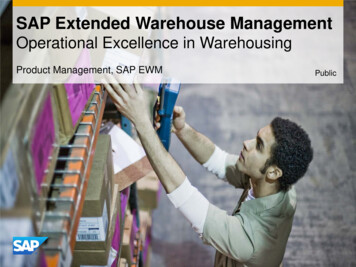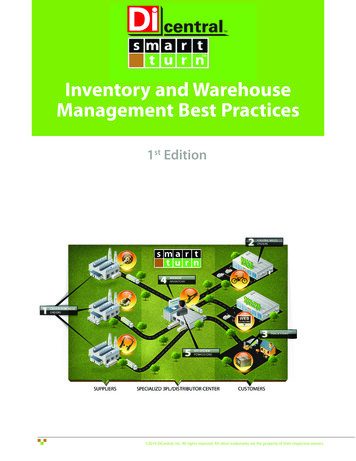
Transcription
Inventory and WarehouseManagement Best Practices1st Edition 2014 DiCentral, Inc. All rights reserved. All other trademarks are the property of their respective owners.
Title herePreface3Introduction4Chapter One: Comparing SaaS to On-Premise WMS7Chapter Two: Warehouse Safety12Chapter Three: Collaboration20Chapter Four: RF Mobile in Warehousing25Chapter Five: Setting Up a Warehouse RF network30Chapter Six: Receiving36Chapter Seven: Slotting41Chapter Eight: Putaway45Chapter Nine: Cycle Counting49Chapter Ten: Replenishment56Chapter Eleven: Picking - Selecting the Right Systems, Methods and Technologies61Chapter Twelve: Kitting and Sub-Assembly66Chapter Thirteen: Picking: How to Do it Right71Chapter Fourteen: Annual/Physical Inventory76Conclusion80SmartTurn Inventory and Warehouse Management Best Practices (1st Edition)BEST PRACTICES SERIESTable of ContentsPAGE 2
BEST PRACTICES SERIESPrefaceGRAPHIC GLOSSARYThroughout this book, you will regularly see the icons below. They call out specific takeaways for you, the reader.Title hereTips:These are specific tasks, ideas, and activities to do or implement.Notes:General observations on process improvement.ROI Opportunity:These are activities and policies that will specifically make you reap tangible benefits. They are specificsteps you can take that promise or can deliver a financial upside through greater efficiencies and savings.COPYRIGHT NOTICESmartTurn is a trademark of SmartTurn Inc. Unauthorized use is strictly prohibited. 2009 SmartTurn Inc.All rights reserved.SmartTurn Inc.177 Fremont StreetSan Francisco CA 94105 USATel: 1 (888) 667-4758SmartTurn www.smartturn.comSmartTurn Inventory and Warehouse Management Best Practices (1st Edition)PAGE 3
Benjamin Franklin and Albert Einstein are two giants of history who knew a thing about getting things done right.The observation that “insanity is doing the same thing over and over again with the expectation of different results”is generally attributed to both of them.Title hereDoes their observation characterize your inventory and warehouse operations?If your operation is one of the tens of thousands of warehouses in the United States still using paper, Microsoft Excel,or processes first developed in the late 70s/early 80s, we’re here to help. To provide you tools, information, guidance,tips, proven methodologies that you can implement throughout your company, we offer you this eBook on “BestPractices for Inventory and Warehouse Management.”SmartTurn created this eBook for business owners, logistics professionals, accounting staff, and procurementmanagers responsible for inventory, warehouse and 3PL operations, as well as anyone else who wants to demystifywarehouse planning and operations.The content in these pages will help you make your operation a higher performing machine. Sure, it is a lofty goalbut you can do better; you just may not know how. We’re here to help you. We won’t preach; just teach. If you’re theowner or manager, this series is for you. If you’re responsible for making your warehousing workplace a more efficient and smoothly functioning profit center, this series is definitely for you. If you aren’t motivated by either makingor saving money, this eBook isn’t for you.LEARNING FROM SUCCESSFUL OPERATORSIn addition to discussing Best Practices as policy and theory, we’re going to discuss how to implement them. Inmany of the chapters, we’ll seamlessly move from the theoretical to the tactical. We’ll profile successful small andmid-sized warehousing businesses, showcasing the steps they took when they implemented these Best Practices.You’ll learn from companies that can stretch a dollar and make three. We’ll look at what works and how well itworks. The showcased companies will discuss how IT investments in inventory and warehouse management haveimproved everything from efficiency and order fulfillment accuracy, to accounts receivable and customer satisfaction. We’ll detail how and why their willingness to change and continually improve has paid off.WHAT ARE BEST PRACTICES?Best practices are the things that successful companies do very, very well. Few companies know supply chain management better than McDonald’s. Research and Development expertise? You’d probably look first to IBM. Brandingand marketing expertise? Apple knows a bit about both areas. Coca Cola has always been renowned for its advertising expertise.Best Practices are the most efficient (takes the least amount of effort) and effective (delivers the best result) way ofaccomplishing something. They’re techniques or methodologies that, through experience and research and quantification, produce better results than whatever was previously done. Better can mean a lot of different things; ingeneral, though, we’re talking faster, cheaper and easier.The Fine Print: Here is the caveat. A commitment to using best practices (in any field) is a commitment to usingall the available knowledge and technology to ensure success. We assume that if you’re going to spend the time toread most (if not all) of the chapters, you’re also going to commit to applying your new expertise and knowledge.We also assume that you are (or at least are interested in) using or learning more about Warehouse ManagementSoftware (WMS) technology, the implementation of which makes these best practices far more possible, likely andpractical.SmartTurn Inventory and Warehouse Management Best Practices (1st Edition)PAGE 4BEST PRACTICES SERIESIntroduction
Title hereHOW TO USE THIS CONTENT?Read the chapters. Think about the lessons. Think about how much easier your life would be if you copied whatreally successful companies were doing. Think about how much more money (sales, revenue, income, etc.) youwould have. Then do it.WHAT THIS EBOOK WILL HELP YOU DO?Make more money. Pay less overtime. Use fewer resources. Reduce operating costs. Lower headcount. Increaseefficiency. Attract, grow, and retain your existing customers. Improve your business processes. Develop insights intoyour business so you can understand where your roadblocks are.You’ll be able to raise your efficiency in receiving, putaway, picking, shipping and inventory management. You’ll beable to increase your on-time, and accurate shipping percentage, and lower overtime costs. You’ll garner insight andhopefully some understanding of the problems that are holding you back from making these next steps. What nextsteps? The next steps you need to increase your efficiency and profitability, etc.HOW IS THE CONTENT ORGANIZED?Logically. The chapters assume that you’re going (or are likely in the near future) to implement an inventory controland WMS system. We’re assuming this much because we want to bring a swift end to your days of exclusively usingpaper, Microsoft Excel, or an outdated, batch-mode warehousing system. There is a better way to do it. (Some ofyour competitors already know this, which you may have already suspected).Here is a preliminary list of initial best practices that we’ll discuss: Planning and SetupWe look at the merits of SaaS, off the shelf, and custom WMS systems, as well as the critical topic of warehousesafety. CollaborationNext, we look at collaboration and its benefits, both inside and outside an organization. How can you create realvisibility that you can share with your teams (everyone who needs to collaborate in the order to cash cycle, forexample)? We’ll discuss the jigsaw pieces that make collaboration possible. We’ll also explore Interoperability,wireless connectivity and wireless network planning and setup. We discuss the most important introductorysteps to take so you can get started quickly and show immediate impact to your business. We also discuss howto recognize when you’re ready for the next step and able to reap the benefits of more advanced technical capabilities. InboundWith the infrastructure necessary for modern collaboration in place, let’s look at how to bring goods into yourwarehouse facilities. We discuss receiving, slotting and putaway and show you how to improve your inbound efficiencies and accuracy. High performance fulfillment begins with accurate putaway. We show you how to createan inbound system that sets the stage for great outbound results.SmartTurn Inventory and Warehouse Management Best Practices (1st Edition)PAGE 5BEST PRACTICES SERIESAccording to industry analysts Aberdeen Group, just 47% of companies are currently taking full advantage of theenabling power of WMS applications to reduce labor costs and improve customer service metrics. After you finishour series, you’ll really wonder how the remaining 53% justify doing less than they ultimately could (from much lessto absolutely nothing at all), given the clear benefits that we’re going to detail.
Once the inventory is in your warehouse, what are you doing with it? How are you managing it? We look at cyclecount policies, cycle counting, replenishment and the annual inventory. When it is time to ship, what do you do?If you’re an experienced warehouse practitioner, or a 3PL managing multiple clients or warehouses, you knowthat more than 50% of operational costs originate with picking. In these chapters, we’ll discuss pick policies,technology that supports better picking, kitting and sub-assembly, and picking.Title hereWHAT’S IN IT FOR YOU?Sure it is a lot of information, but we’re giving it to you in carefully measured 200 calorie chunks. You’ll have lots oftime to digest them. This is important because we’d like you to chew on the following:According to the American Productivity & Quality Center, the three main barriers to implementing best practices area lack of knowledge about current best practices, lack of motivation to make the necessary changes to adopt them,and a lack of knowledge and skills required to implement them.Read every chapter in this eBook and you’ll immediately eliminate the first barrier. By the time you’ve enthusiastically read all the chapters (and perhaps even read them a second time), you’ll have a clear idea of what works well,the mistakes you should avoid, and have some idea of how to apply some or all of the lessons in this series to yourparticular and, dare we say it, unique situation.We take care of the second barrier by providing you with evidence (both empirical and anecdotal) of the benefitsand ROI of implementing these best practices. Because we showcase companies that have successfully implemented change, we eliminate the third barrier. You won’t have any more knowledge barriers. Instead, you’ll have aglorious opportunity to become a Best Practices-implementing guru at your company. Worst case scenario? You’llbe one step ahead because you’ll know what you don’t know.Consider the alternative: you can continue what you’re currently doing and fall further behind your competition. Bydoing nothing, you can ensure that one day, you’ll be out of business or out of a job. Reading these chapters willhelp you avoid both fates.SmartTurn is committed to fostering a self-sustaining community of inventory and warehouse experts throughknowledge sharing and learning. Whatever your motivation, we invite you to read this eBook and raise the level ofoperational excellence in the inventory and warehouse management innovation communities.SmartTurn Inventory and Warehouse Management Best Practices (1st Edition)PAGE 6BEST PRACTICES SERIES Inventory Management and Fulfillment
Title hereYou already knew after reading the introduction that implementing a Warehouse Management System (WMS) wasinevitable.You might have already implemented one. You might even be currently editing a WMS Request for Proposal as a firststep. Or, your eyes might be closed shut, hoping that WMS vendors stop calling you, and Modern Materials Handlingwriters stop writing glowing WMS case studies. Sorry, you can’t ignore their ample benefits any longer. You reallyneed a WMS to implement your industry’s best practices. But what type?TO SAAS OR NOT TO SAASLet’s begin our WMS conversation from the perspective of Software-as-a-Service (SaaS) vs. on-premise software. Itis vital to understand their similarities and differences. The applications loaded on your laptop or desktop are examples of on-premise software. A common example is Microsoft Office. QuickBooks hosted on your network server isanother. The commonality is that you own (or rather, technically license from the software vendor) the applicationand host it on-site at your place of work. In fact, if you read the fine-print of your on-premise license agreement,you’ll discover that rarely do you actually own the software.DEFINING SAASOK, it is growing in popularity but what exactly is SaaS? Information technology industry analysts Gartner Groupdefine SaaS as “hosted software based on a single set of common code and data definitions that are consumed in aone-to-many model by all contracted customers, at any time, on a pay-for-use basis, or as a subscription based onusage metrics.” In the SaaS delivery model, software vendors host applications over the Internet and deliver themto customers for a recurring license fee. Instead of launching applications from your hard drive, you access them viaweb browsers such as Internet Explorer, Firefox, Safari and Opera. One of the most common SaaS delivery models isthe single instance, multi-tenant arrangement in which a common version of the software is hosted at a central location and used by many different companies. Any employee with access via subscription (usually restricted throughunique user names and passwords) can log in and begin working.WINDS OF CHANGEWhile on-premise has been the application delivery standard for decades, the SaaS delivery model in which youaccess applications through a Web browser is a more recent (and increasingly popular) application delivery option.SaaS enables software companies to build powerful, highly secure, and flexible applications and then deliver themto a broad customer base.SAAS BENEFITSThere
You’ll be able to raise your efficiency in receiving, putaway, picking, shipping and inventory management. You’ll be able to increase your on-time, and accurate shipping percentage, and lower overtime costs. You’ll garner insight and hopefully some understanding of the problems that are holding you back from making these next steps. What next
